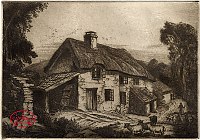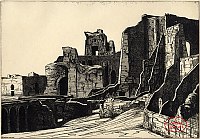 |
|
Edward Bouverie-Hoyton1900 - 1988 |
|
|
Click on a picture for more details |
|
|
Edward Bouverie-Hoyton was one of the talented group of etchers and engravers to emerge from Goldsmith’s College, along with Graham Sutherland, Paul Drury and William Larkins. It was at Goldsmith's that Bouverie-Hoyton had learned the art of etching and engraving from Stanley Anderson and Malcolm Osborne but he was much influenced and helped by F.L. Griggs whom, he recalled, “taught me more in one day than anyone else, about printing a plate really well.” In 1926 Edward Bouverie-Hoyton won the coveted Prix de Rome for engraving and he spent the next three years at the British School in Rome, travelling widely throughout southern Europe. In 1936 he was elected to the Royal Society of British Artists and in 1958 became a Fellow of the Society of Artists. In 1941 Bouverie-Hoyton was elected as Principal of the influential Penzance School of Art. He was also Vice President and Chairman of the St.Ives Society of Artists. A regular exhibitor at the Royal Academy throughout his life, Bouverie-Hoyton was a close friend of Graham Sutherland, and it was Hoyton who introduced Sutherland to Ben Nicholson. In early 2000 a complete archive of Edward Bouverie-Hoyton’s printed works, now known as The Edward Bouverie-Hoyton Collection was purchased for the nation from his descendants by The National Art Collections Fund with the support of the Victoria & Albert Museum Purchase Grant Fund. Comprising over 200 printed works spanning six decades, the Collection is now housed at Aberystwyth in Wales. [more] |




